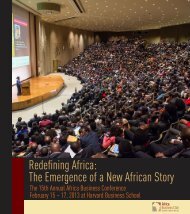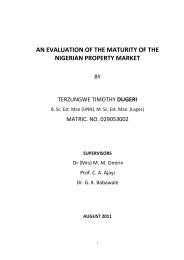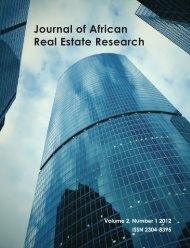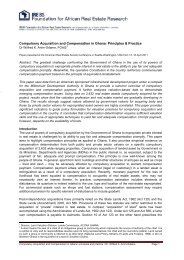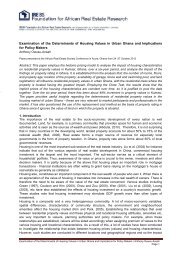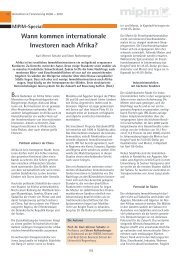facing unprecedented decline in demand and price due to theglobal economic slowdown.Growth has been recorded in all categories of merchandiseimports except for food. Import of intermediate goodscontinued to dominate merchandise imports. Oil importsincreased substantially between 2008 and 2010.Monetary PolicyTanzania’s monetary policy is formulated by the Bank of Tanzaniausing instruments, such as Refinancing Policy, Minimum ReservePolicy, Open Market Policy, Foreign Exchange Interventions, andother instruments. The attainment of the Monetary Policyobjectives is facilitated by a continued application of marketoriented policies in the financial sector, the public sector, theindustrial sector, the agricultural sector and the externalpayments regulatory regime.Legal SystemThe highest court in Tanzania is the Court of Appeal, which hasappellate jurisdiction over the whole of the Republic of Tanzania.To deal with the more complex issues arising in a liberalisedeconomy (such as international business, finance, intellectualproperty and land matters), separate divisions of the High Courthave been established for commercial and land matters.Intellectual PropertyThe Copyright and Neighbouring Rights Act, Revised Edition2002, provides for the protection of copyright and neighbouringrights in literary, artistic works, folklore and other relatedmatters.The Trade and Service Marks Act No. 12 of 1986 provides for theregistration and protection of Trade and Service Marks and forconnected matters.The Patent Act, Revised Edition 2002, provides for thepromotion of inventions and innovation for the facilitation of theacquisition of technology on fair terms through the grant andregulation of patents, utility certificates and innovationcertificates.BankingThe Bank of Tanzania bears the responsibility of establishingconducive monetary stipulations that generate low and stableinflation.The Banking and Financial Institutions Act No.5 of 2006 (BFIA)consolidates the law relating to business of banking, toharmonize the operations of all financial institutions in Tanzania,to foster sound banking activities, to regulate credit operationsand provide for other matters incidental to or connected withthose purposes.InsuranceThe Insurance Act No.10 of 2009 came into force on 1 July 2009and established the Tanzania Insurance Regulatory Authority(TIRA) which, among other things, is vested with the powers toregulate the insurance market in Tanzania as well as to promoteand maintain efficient, fair, safe and stable insurance market forthe benefit and protection of insurance policyholders.Key Strategic Growth Initiatives by Government/Private SectorThe National Strategy for Growth and Poverty Reduction(NSGRP) has identified Private Sector Development (PSD) as animportant source of Tanzania’s economic growth. The strategystipulates that domestic firms, including Small MediumEnterprises (SMEs) will be supported and encouraged to beinnovative, pay attention to product development, quality andsuperior marketing strategies that make them competitive andcapable of responding to global market conditions.The Government of Tanzania has made ‘Agriculture First’ thetheme of the current budget. The initiative, created by theTanzania National Business Council, recognizes the importanceof the agricultural sector in improving the country’s socioeconomicstate and aims to radically revamp it, in conjunctionwith the private sector.Public Private PartnershipThe Public Private Partnership Act No. 19 of 2010 becameeffective on 18 June 2010. Its main purpose is to promote privatesector participation in the provision of public services throughpublic private partnership projects involving investment capital,managerial skills and technology.Economic EmpowermentThe Government of Tanzania implemented the NationalEconomic Empowerment Policy of 2004 by providing soft loansthrough various funds and programmes, sensitization on formingcooperatives (SACCOS) and Village Community Banks (VICOBA),as the best way of achieving soft loans, income generation,employment and poverty reduction.The Government of Tanzania continues to implement theNational Economic Empowerment Policy by disseminating it tothe majority of citizens to enable them to understand it andparticipate effectively in its implementation. It provides trainingto entrepreneurs, sensitization on savings and investments, andconducts studies aimed at developing entrepreneurship skills, aswell as initiating and improving economic activities. In addition,the Government will also continue to promote participation ofpeople in development activities through the Tanzania SocialAction Fund (TASAF).Treaties and Bilateral AgreementsTanzania has entered into bilateral treaties for the promotionand protection of foreign direct investment (FDI) with Denmark,Finland, Germany, India, Italy, Netherlands, Norway, Sweden,Switzerland, United Kingdom and Zambia.Tanzania is a member of several international <strong>org</strong>anizationsincluding The International Centre for the Settlement ofInvestment Disputes (ICSID) and the Multilateral InvestmentGuarantee Agency (MIGA). Tanzania is also a signatory to theNew York Convention on the recognition and enforcement ofArbitration Awards.Membership of International and Regional OrganisationsTanzania is a member of the United Nations Organisation, the<strong>Africa</strong>n Union, the East <strong>Africa</strong>n Communityand the Southern <strong>Africa</strong>n DevelopmentCommunity.Road and TransportTransport in Tanzania is mainly by road,79
supplemented by a series of railway networks. Tanzania’s roadnetwork is of limited quality and not many roads are tarred.Tanzania has an abundance of coastal and lake waterwaysaround its borders. The active ports are Dar es Salaam, Tanga,and Mtwara. There are also the minor ports of Kilwa, Lindi andMafia on the Indian Ocean.WaterTanzania has sufficient water resources to meet most of itspresent needs. They include surface and underground sources.EnergyElectricity generation, transmission and distribution in Tanzaniaare through the Tanzania Electric Supply Company (TANESCO).The company is 100% government owned and is responsible for98% of the country’s electricity supply. Petroleum, hydropowerand coal are the major sources of commercial energy in thecountry.mineral deposits such as soda ash, kaolin, granites, marble andquartzite. Salt is found along the coast and inland lakes, alongwith vermiculites, limestone, silica sands, phosphate, gypsumand mica.On 23 April 2010 the Mining Act No.14 of 2010 came into forcerepealing the Mining Act No. 5 of 1998. The 2010 Mining Act reenacted,with substantial amendments, the laws relating toprospecting for minerals, mining, processing and dealing inminerals, granting, renewal and termination of mineral rights,payment of royalties, fees and other charges. The Mining Act2010 increased the tenure of a prospecting license to a total of 9years. Under the previous statute the maximum period for aprospecting license was 7 years.TelecommunicationsTelecommunication was the fastest growing sector in Tanzania in2009. Tanzania has the second largest telecommunicationmarket in East <strong>Africa</strong>, after Kenya. Teledensity has risen from 1%in 2001, to 39% in September, 2009 representing a subscriberbase of 16.2 million people.The Electronic and Postal Communications Act No. 3 of 2010came into force on 20 March 2010. It sets out the procedure forregulating the communication industry. One of the highlights ofthis statute is the requirement to register all detachable SIMcards and built-in SIM card mobile telephones. The objective isto enhance national security, to protect consumers from misuseof communication services, to enable consumers to be identifiedwhen they use value-added services such as mobile moneytransfer. Another key highlight is the requirement for existinglicensees of network facilities, network services, applicationservices or content services to offer their shares to the publicand subsequently list these shares on the stock exchange threeyears from the commencement of the statute, providedhowever that the listing of such shares is in line with the listingrequirements of the Capital Markets and Securities Authority.AgricultureThis sector is still dominated by subsistence farming. Food cropsmake up the majority of the sector - about 85% contributing toabout 20% to GDP alone, with livestock accounting for 3%. Majorfood crops include cassava, millet, maize, s<strong>org</strong>hum, rice, wheat,pulses (mainly beans) potatoes, bananas and plantains.The country produces a variety of export cash crops chieflytobacco, cotton, sisal, coffee, cashew nuts, pyrethrum, tea,cloves, horticultural crops, oil seeds spices and flowers.MiningTanzania is <strong>Africa</strong>'s third largest gold producer behind South<strong>Africa</strong> and Ghana and is estimated to have gold reserves of morethan 1 000 tonnes. Tanzania boasts a variety of other mineralsincluding tanzanite, silver, copper,diamonds, rubies, sapphires, base metals,platinum, coal, agro-minerals and chemicaland industrial minerals.80Tanzania also has a range of industrial



